Fri 3 Jun 2022
A Movie Reviw by Jonathan Lewis: IN THE LINE OF FIRE (1993).
Posted by Steve under Action Adventure movies , Reviews[8] Comments
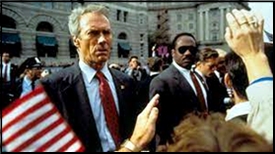
IN THE LINE OF FIRE. Columbia Pictures, 1993. Clint Eastwood, John Malkovich, Rene Russo, Dylan McDermott, Gary Cole, Fred Dalton Thompson, John Mahoney. Directed by Wolfgang Petersen. Currently streaming on Netflix and Hulu.
As a thriller starring Clint Eastwood as a grizzled, aging Secret Service Agent obsessed with guarding the President from a dedicated assassin, In the Line of Fire was both a critical and commercial success. It’s not difficult to see why. First, there’s star power in Clint Eastwood, cast as the lead. Bitter, determined, and prone to acerbic quips, Frank Horrigan (Eastwood) is a late fifty-something who has the unfortunate distinction of being the only currently operative agent who was with John F. Kennedy on that fateful day in Dallas. Some thirty years later, Horrigan can’t seem to shake the feeling that, had he made different decisions, he might have been able to stop Lee Harvey Oswald.
When Horrigan begins to investigate yet another potential threat to the president, he immediately finds himself embroiled in a deadly cat-and-mouse game with James Carney (John Malkovich). Portrayed with an intensity that matches – and often overwhelms Eastwood’s – Malkovich’s Carney is a skilled, but deeply paranoid antagonist.
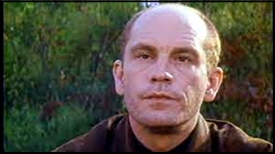
Malkovich, never one too phone in a performance, takes the role and imbues it with pathos. Carney – who likes to be called “Booth†– is a man who passionately believes that the country he once served has abandoned him. And he thinks he has found a kindred spirit in Horrigan. Little does he know that behind the gruff, sullied exterior, Horrigan is a true believer and dedicated patriot who, despite it all, still believes in his career choice.
Horrigan’s personal life and code of honor is explored not so much by what he says – his rhetoric always seems to more aggressive than his heart – but how he conducts himself with others. That’s why his would-be romance with fellow agent Lilly Raines (Rene Russo) and his friendship with his younger partner Al D’Andrea (Dylan McDermott) are so key to the film. Neither is a distraction.
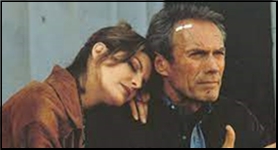
Rounding out the cast are a coterie of actors who were quite familiar to contemporaneous audiences. John Mahoney, best known for his portrayal as the father on Frasier, is cast as the head of the Secret Service. Fred Dalton Thompson, politician as well as actor, portrays the president’s Chief of Staff. Look for Steve Hytner (Kenny Bania on Seinfeld) as Secret Service Agent Tony Carducci and a youthful Joshua Malina as Tony Chavez, another agent.
Speaking of the 1990s, there’s a very early 1990s aesthetic to In the Line of Fire. The cinematography, the action sequences, and the somewhat sanitized interiors squarely places the film into the same time frame as JFK (1991) and The Fugitive (1993). Compared to 1970s cinema, early 1990s films are a bit flatter, less gritty, and more polished – even if the plot involves an unhinged assassin or conspiratorial villain.
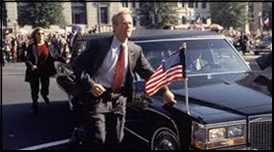
This past week was the second time I’ve watched In the Line of Fire. The first must have been around the time it was released. While it still holds up as a solid work of film making, I can’t say that it was necessarily as enjoyable this time around. A lot of the plot seems to repeat itself, with Horrigan and his colleagues constantly chasing false leads. And the prime piece of evidence that enables Horrigan to discover Carney’s alias – a scrap of paper with something written on it – seems a little too pat.
Still, it’s an exceedingly watchable film with a strong cast. I just wish the director had leaned a bit more into Carney’s madness. But then again, had he done so, it would have been Malkovich’s film, not Eastwood’s. Maybe that could have worked even better?
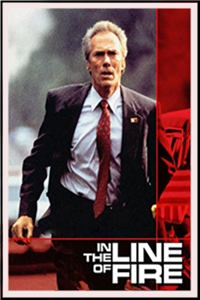
June 3rd, 2022 at 10:26 pm
While Eastwood is strong in this at every turn with Malkovich it threatens to become a DAY OF THE JACKAL style film while you almost root for the villain at the same time waiting for him to meet justice and his fate.
The two sides of the same coin isn’t a new theme in these kind of films, but here at least both sides are interesting with Eastwood, if not quite as interesting as Malkovich, still able to hold us enough we don’t regret the time with his character.
Ironically, I think I liked it better the second time I watched it when I was able to pay less attention to the plot and action and savor the performances by Eastwood, Malkovich, and Russo. No one in the film is bad, but those three stand out.
June 4th, 2022 at 10:13 am
David: I think it was Robert Altman who said he always had to watch movies twice in order to appreciate them because the first time he was always too ‘distracted’ by the plot to pay proper attention to the filmmaking.
June 4th, 2022 at 10:57 am
Actually, as I recall, altman’s quote was closer to ‘I haven’t actually seen a movie until the 2nd time I watch it, as I’m too distracted by the plot the first time to actually ‘see’ it.’ This quote, btw, makes no sense to me personally as I am an almost completely non-visual, logocentric kind of guy. Which is to say that the narrative, in the film world of my head, is nearly everything.
June 4th, 2022 at 11:19 am
I recall Altman taking a somewhat different approach: ‘When I complete casting 85 percent of my work has been done.’
It may be he was just talking to be heard by sycophants in the press.
June 4th, 2022 at 11:46 am
Barry: the quote I paraphrased was about being a film consumer rather than a filmmaker. As a filmmaker you are right. He was very Laissez faire in his approach and let the actors freely ad lib. I was at a talk by michael murphy where he said he started out doing only Altman movies and was completely shocked and surprised by his own incompetence when he later tried to act in other projects where he was expected to stick to the script. Altman’s was a completely alien way of directing at the time. Per Wikipedia (I know I know), jack warner took away final cut from altmans first film after being chagrined with the dailies showing overlapping dialogue (which was an Altman staple for its effect of verisimilitude).
But with regards to ‘I only see a movie the second time I watch it’—my wife views films completely different from myself and is in complete agreement with Altman. All she looks for in films is lighting and verticals/horizontal lines, rhythms of shot cuts, geometry, camera angles and movement, tracking shots, color, montage and stuff like that. I never notice any of that. And I really just don’t care. I’m more into the narrative which is why I personally find it really tedious to watch a film twice in succession.
June 4th, 2022 at 12:44 pm
I seldom have the time to watch a movie a second time. As much as I sometimes think I might like to, there are too many others to watch.
But it was interesting to note Jon and David’s opposing thoughts on their respective second watchings of this one.
June 4th, 2022 at 1:23 pm
Steve,
In the Line of Fire is absolutely terrific, and nearly 100% of that goes to Clint Eastwood and Wolfgang Peterson plus the supporting cast. As for Malkovich, an adequate, ugly performance that I cannot get off on as I’ve no interest in guys who try to kill presidents or play them in the movies.
March 18th, 2023 at 1:09 pm
Clint Eastwood, 62, did hang six storeys above the earth on the ledge sequence (with the use of a safety belt), but stuntmen executed the jump and fall onto the fire escape.